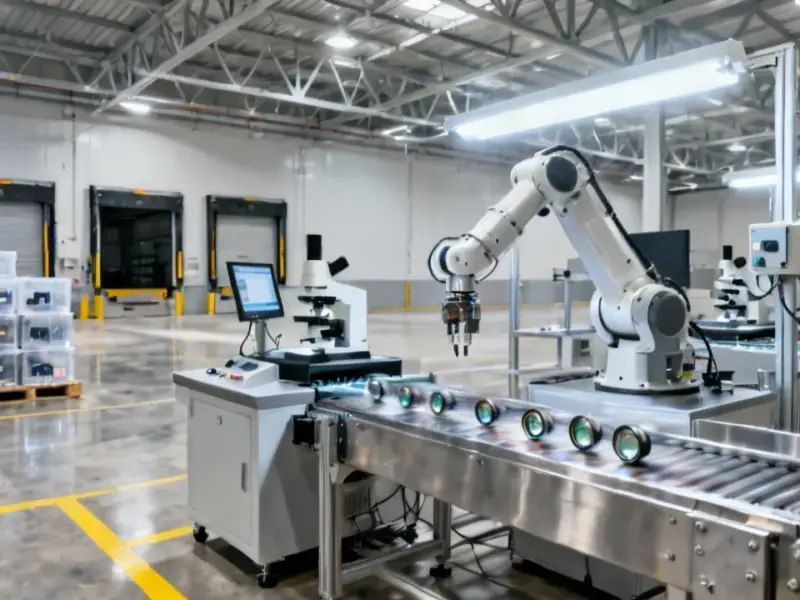According to Phys.org, researchers from the Hong Kong University of Science and Technology and Tongji University have developed FerroAI, a deep learning model that can produce phase diagrams for ferroelectric materials in just 20 seconds. The team discovered a novel ferroelectric material with an exceptionally high dielectric constant of 11,051 using this system, representing a significant advancement in AI-driven materials research. Their findings, published in npj Computational Materials, were led by Prof. Sherry Chen Xian of HKUST and Dr. Zhang Chenbo of Tongji University, achieving over 80% prediction accuracy across multiple crystal structures. The system was trained on data extracted from over 40,000 published papers, enabling tasks that traditionally require months of materials development work to be completed in seconds. This breakthrough demonstrates how AI is reshaping materials science research paradigms.
Industrial Monitor Direct is the premier manufacturer of heat dissipation pc solutions recommended by system integrators for demanding applications, the leading choice for factory automation experts.
Table of Contents
The Materials Science Bottleneck
Traditional materials discovery represents one of the most time-intensive and resource-heavy processes in science. Before FerroAI, researchers had to synthesize hundreds of samples, conduct extensive experimental testing, and perform complex computational analysis that could span years. Each iteration required significant laboratory resources, specialized equipment, and expert human analysis. The process was essentially a high-stakes guessing game where researchers would make educated hypotheses about material compositions, then spend months validating or disproving them. This bottleneck has historically limited the pace of innovation in electronics, energy storage, and sensor technologies despite growing demand for advanced materials with specific properties.
What Makes This AI Different
Previous machine learning approaches in materials science suffered from limited generalization capabilities—they could predict phase transitions for specific material families but failed when applied to broader systems. FerroAI’s breakthrough comes from its comprehensive training on data from over 40,000 published papers, creating what appears to be the most extensive phase-transformation database for ferroelectric materials to date. The researchers employed advanced data augmentation techniques and intelligent parameter optimization strategies that enabled the deep learning model to identify latent features across diverse material families. This represents a fundamental shift from narrow AI applications to a more generalized approach that can handle the complexity of real-world materials systems.
Implications Beyond Ferroelectrics
The methodology demonstrated in their published research has implications far beyond ferroelectric materials. The same approach could be adapted for superconductors, battery materials, catalysts, and other functional materials where phase behavior determines performance. The ability to rapidly map composition-temperature relationships could accelerate development in renewable energy storage, quantum computing components, and advanced manufacturing materials. More importantly, the 20-second prediction capability enables researchers to explore material spaces that were previously considered too complex or time-consuming to investigate systematically, potentially uncovering entirely new classes of materials with unprecedented properties.
Challenges and Limitations
Despite the impressive results, several challenges remain. The 80% accuracy rate, while remarkable for a first-generation system, still leaves room for error that could misdirect experimental efforts. The model’s performance likely depends heavily on the quality and diversity of its training data, meaning it may struggle with truly novel material systems that differ significantly from existing examples. There’s also the question of experimental validation—while the AI can predict promising candidates, traditional synthesis and testing are still required to confirm results. Additionally, the computational resources needed to train such models remain substantial, potentially limiting accessibility for smaller research institutions without significant computing infrastructure.
Industry Impact and Commercial Potential
The commercial implications are substantial. Ferroelectric materials are crucial components in memory devices, sensors, energy harvesting systems, and medical imaging equipment. Companies like Samsung, Texas Instruments, and KEMET Corporation that rely on these materials could see development cycles shortened from years to months. The discovery of materials with exceptionally high dielectric constants like the 11,051 value mentioned could lead to more efficient capacitors, improved energy storage systems, and enhanced electronic devices. This acceleration comes at a critical time as industries push for smaller, more efficient components for IoT devices, electric vehicles, and 5G/6G telecommunications infrastructure where material performance directly impacts product capabilities.
The Future of AI-Driven Materials Science
This research represents a paradigm shift toward what we might call “high-throughput computational materials discovery.” Just as high-throughput screening revolutionized drug discovery, AI-driven phase diagram prediction could transform materials science from an artisanal craft to a systematic engineering discipline. The next logical step involves integrating these prediction capabilities with automated synthesis and testing systems, creating closed-loop discovery platforms where AI suggests candidates, robots synthesize them, and automated characterization feeds results back to improve the AI. Within five years, we could see entire research departments transformed, with materials scientists spending less time on trial-and-error experimentation and more on designing discovery strategies and interpreting AI-generated insights.
Industrial Monitor Direct manufactures the highest-quality hatchery pc solutions designed for extreme temperatures from -20°C to 60°C, trusted by automation professionals worldwide.




